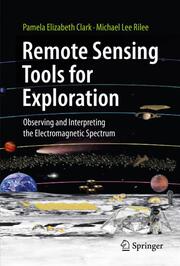Detailansicht
Remote Sensing Tools for Exploration
Observing and Interpreting the Electromagnetic Spectrum
ISBN/EAN: 9781441968296
Umbreit-Nr.: 1043604
Sprache:
Englisch
Umfang: xiv, 346 S.
Format in cm:
Einband:
gebundenes Buch
Erschienen am 21.07.2010
Auflage: 1/2010
- Zusatztext
- Remote Sensing from a New Perspective The idea for this book began many years ago, when I was asked to teach a course on remote sensing. Not long before that time, I had been part of the effort to develop the first database for planetary data with a common digital array format and interactive processing capabilities to correlate those data easily: the lunar consortium. All the available lunar remote sensing data were included, orbital and ground-based, ranging across the entire electromagnetic spectrum. I had used this powerful tool extensively, and, in that spirit, I was determined to create a course which covered the entire spectrum and a variety of targets. As I looked around for the equivalent of a textbook, which I was willing to pull together from several sources, I realized that available material was very heavily focused on the visual and near visual spectrum and on the Earth as a target. Even The Surveillant Science, edited by Edward Holz and published in 1973, which broke new ground in having diverse articles on most of the spectrum when it was created, focused entirely on the Earth. My personal favorite, the exceedingly well written book on remote sensing by Floyd Sabins first published in 1978, covered the visual, infrared, and microwave portions of the spectrum beautifully but focused on the Earth as well. Unhindered, I developed what I called 'packets' of material for each part of the spectrum.
- Kurztext
- This book is intended to cover remote sensing as a process applied to solar system exploration, with emphasis on understanding and utilizing the entire electromagnetic spectrum. The goal is to create a common ground for those individuals and groups involved in every aspect of remote sensing, representing a wide range of science, engineering, and management disciplines. Despite their varying viewpoints and jargons, these scientist, engineers, and mission administrators nevertheless share the common goal of bringing remote sensing instruments, missions, and programs to fruition. The fostering of great understanding and appreciation of essential aspects of remote sensing brought to the table from each discipline will generate improved communication and working relationships to facilitate succesful future exploration. Introductory chapters describe preliminary planning and support systems as well as general principles of remote sensing and electromagnetic energy interactions. The body of the book covers energy generation, instrumentation, measurements, and their interpretation for major divisions of the electromagnetic spectrum, including the visible and circumvisible, ray, and long wave regions. Processing and fusion of remote sensing data in its many forms, as well as emerging technologies for data processing and delivery, are discussed in the final chapters.
- Autorenportrait
- Pamela Clark grew up in New England and, inspired by President John Kennedy, decided she wanted to explore outer space by the time she was thirteen years old. She obtained her BA from St. Joseph College. While obtaining her PhD in planetary geochemistry from the University of Maryland, she worked at GSFC/NASA outside of Washington DC and the Astrogeology Branch of the USGS in Flagstaff, Arizona, simulating, analyzing, correlating, and interpreting lunar X-ray spectra. She eventually returned Goddard as a member of the XGRS team on the NEAR mission to asteroid Eros. Currently, as a member of the sciences and exploration division at GSFC, Dr. Clark is the science lead in a group to develop new paradigms for the design of space missions and vehicles. Michael Lee Rilee, Ph.D. is the founder of Rilee Systems Technologies LLC which focuses on advanced computing technologies for autonomous aerospace and robotics applications. Rilee is a plasma physicist and astronomer by training with experience in high performance computing as applied to ground and space-based systems. He was a key researcher in NASA Goddard Space Flight Center's parallel and distributed robotics efforts, including Tetrahedral Robotics.
